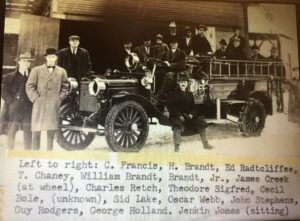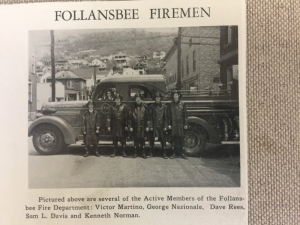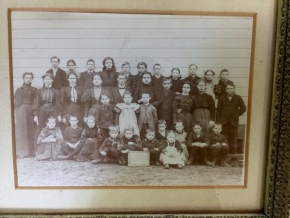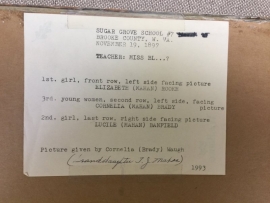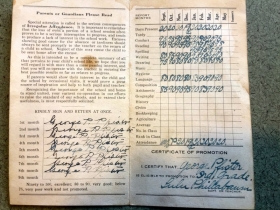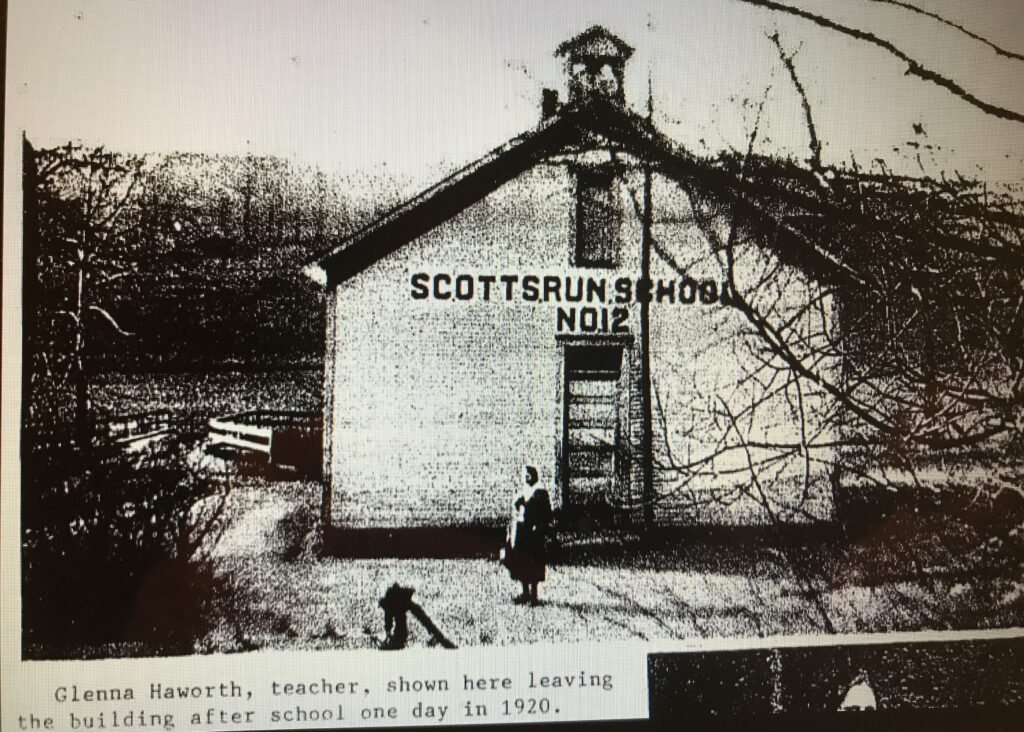A curfew ordinance was established in Follansbee requiring children under 16 to be off the streets by 8 p.m. unless they’re with their parents.
1907- First Volunteer Fire Department
The first fire department was located on the Penn Street city lot next to where the City Building is situated today. The fire alarms were made with the Follansbee mill whistle. In 1907, a chemical fire wagon was purchased for $660 from Zanesville, Ohio. In 1909 the city installed fireplugs. (See also October 1920, “Duke” City Mascot and Fire Dog).
Photo Below includes firetruck purchased in 1917 & volunteers from left to right Clarence Francis, Harry Brandt, Edw. Rateliffe, Lawrence Chaney, ‘Mascot’ Jack Brandt, William Brandt, James Krick, Jenkin Jones, Charles Petch, Fred Dennis, Theodore Seigfried, Sidney Lake, Oscar Webb, Cecil Bole, John Stephens Sr, Hugh McBane, and George Holland.
Photos courtesy of Follansbee Library Brooke Co. Div.
Follansbee Review/ “Some Members of Follansbee Volunteer Fire Dep’t”, Jan 19, 1917, p.5
1907 – Jefferson Glass Company Opens
Initially located in Steubenville, Jefferson Glass moved to Follansbee in 1907. One of its founders was Dohrman J. Sinclair (1860-1915) who earlier persuaded the Follansbee Brothers to build on the land to become the city of Follansbee. The company took its name from Jefferson County where it was originally located. According to an early history of the company, the plant made illuminating glassware and automobile specialties such as lenses. During the late teens and early 1920s, products from the plant were found in 90% of all automobiles. During World War I, the company made naval glass components. However, the company is famous for its hand-decorated and opalescent crystal glassware, as well as pressed, blown, and marbleized glass. ” In 1907, Jefferson Glass obtained a patent to mark some of their wares “Chipendale” with “Krystol” on the bottom of the pieces.” Jefferson Glass products became nationally famous. While stationed for training during World War II in the Chicago area, Hugo Broccolini of Follansbee noted that the chandeliers in Chicago’s Stevens Hotel were made at the Jefferson Glass House. Jefferson Glass also had a large European trade with warehouses in London and Germany.
Located at the south end of town adjoining the railroad, the Jefferson Glass Company went bankrupt in 1933 during the Depression. Local Brooke county families will recognize many of the names of employees who worked there. Here is a partial list: Vincent Beck, Mr. Blumenhaurer, Hugo Broccolini, Leo Bund, D.J. Coyne, John Deer, Sr., Whitney Evans, Edward Geary, John Good, Emil Hagberg, James Haydn, Flora Johnson, Werner Johnson, Eugene Maillard, Emma Baldaug Straka, Jim Shay, Otto Peterson, Mr. Wilson, Gus Yandalia, and Harry Walker.
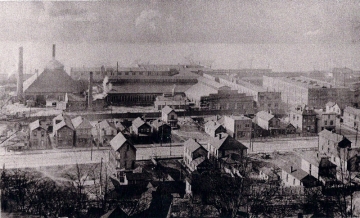
Glass house is the big building on the left, circa 1915. Photo courtesy of W.Va. State Archives.
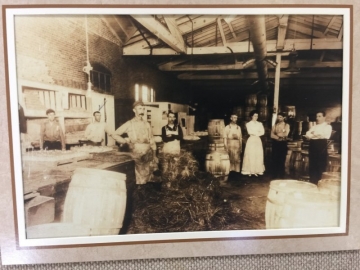
Jefferson Glass Co. workers 1907. Edward Hugh Sanders 2nd from left. Photo courtesy of Brooke Co. Historical Society.

1920 Glass House Co. Photo courtesy ofJoe Settimio.
- The History of West Virginia, Old and New, “Jefferson Class Company,” (Chicago: The American Historical Society, Inc., l923, Vol. 3,) pp. 464-465.
- “Early Glass Houses of Brooke County,” Article written in 1975, See http://www.brookecountywvgenealogy.org/industrial2.html
1907 – Discovery Of The Follansbee Oil Field
In 1907 the La Belle Iron Works of Steubenville, desiring to prospect for gas, purchased a track of 190 acres from the Ohio River Realty Company, just east of the P.W.& Ky. railroad tracks, and began drilling. In additional to finding gas, they got a sixty-barrel a day oil well. The realty company, which owned land between the railroad and river put down a well in January 1908, and had a 400-barrel gusher. Derricks went up all over the oil field just above the new town of Follansbee. By the summer of 1909 at least seventy-five derricks were producing 3,000 barrels daily. The Follansbee field, which formerly was part of the Mahan estate, extended to the river edge and was sold out by Ohio River Realty to Ferguson & Company in 1909. The Follansbee field immediately sparked a rush to get holdings and erect derricks along the Ohio River bottoms in Steubenville and Mingo. The Follansbee field was considered dangerous by the men working in it because the wells were close together.
The Ohio Valley Reality Co. initially purchased 600 areas, or nearly all of the Mahan estate where the oil field existed. In 1908 some of the owners of oil wells in the Follansbee field included the following: La Belle Iron Works Co., 1.305 barrels per day; Ohio Valley Realty Co., 3.520 barrels per day; Mahan Oil Co., 380 barrels per day; Mahan & Ferguson, 160 barrels per day; and J. D. Owens & Co., 10 barrels per day.

Photo Follansbee Library Brooke Co. Division.
Wells along river side near Mahan Lane.
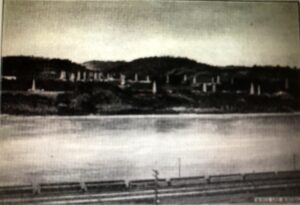
- Mines and Mines, “Oil Field at Follansbee, W.VA.” December 1908, p. 207.
- http://books.google.com/books?id=mKc5AQAAIAAJ&pg=PA207&lpg=PA207&dq=la+Belle+Iron+works+in+Follansbee
- The Pittsburg Press, “New Oil Producer May Extend Producing Area in Lower Southwest Fields,” June 21, 1908.
- http://news.google.com/newspapers?nid=1144&dat=19080621&id=vwkbAAAAIBAJ&sjid=x0gEAAAAIBAJ&pg=3715,4256863
1906 – First Catholic Mass In Follansbee
In September 1906, Rev. M. Madert said first Mass in Mahan’s Hall. Later Mass was delivered in a private home on Allegheny Street and from 1909 to 1910 in Exner’s Hall. Later, Father Madert bought some property on Jefferson Street and established a small church in 1911. Bishop Donohue blessed the Church on May 7, 1911. Rev. Henry Parascandola was assigned its first resident pastor. He acquired properties on the corner of Jefferson and Raymond streets. In June 1913, a bell was placed on St. Anthony’s Church. “The bell was rung a long time and clear tones were heard distinctly in all parts of the town.”
The above photo taken in 1922 is considered to be of an early Catholic Church constructed about 1911. It appears to be standing on the corner of Raymond and Jefferson streets.
Josephine B. Smitz is the young girl in the center of the picture and Mother of Lorreta (Smitz) McBride who contributed the church photo.
The house in the upper right side of the photo is the “Blue House” constructed by Herman Mahan in 1876. Herman with his brother Thomas sold land to the Follansbee brothers who built the Follansbee Mill 1902-04. The Blue House is still standing today.
- St. Anthony Parish 100th Anniversary Celebration: 1906-2006. Follansbee, WV. November 5, 2006, p. 1.
- Mill Towns Review, “Catholic Church Now has a Bell,” June 6, 1913, p. 5.
- Church Photo courtesy of Thomas and Lorreta (Smitz) McBride.
1906 – Citizens Bank Of Follansbee
The Citizens Bank was a major actor in the building of the community. The bank furnished the money to build over 85 percent of the houses in the city by 1914. The Follansbee Brothers received cash from the Citizens Bank for its pay rolls all through the panic of 1907-1909 at a time when other plants were compelled to pay in script. The location of the Citizens Bank of Follansbee was in the historic building still standing at the corner of Ohio and Main streets. Its lasting symbol was a grand standing clock that kept customers on time as they entered the Bank.
- Mill Towns Review, “Citizens Bank,” July 10, 1914, front page.
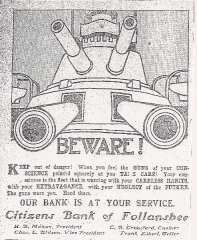
1914 Mill Towns Review newspaper ad for Citizens Bank building on the WWI threat in Europe.
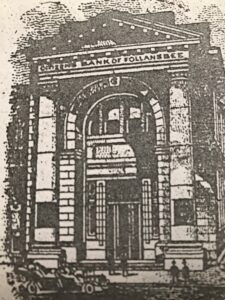
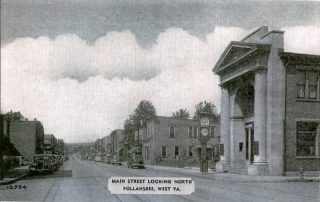
Actual photo of bank as it looks today
1906 – Christian Church Organized
An early picture of what is considered the original Christian Church building (no longer in existence) was located on the corner of Neville and Penn street. See photo.
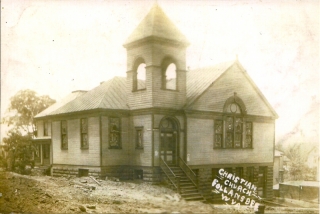 Christian Church, at the corner of Neville & Penn Street, Circa 1914. Photo courtesy of James Piccirillo.
Christian Church, at the corner of Neville & Penn Street, Circa 1914. Photo courtesy of James Piccirillo.

Because of the rapid growth of its members, the Follansbee Christian Church was entirely rebuilt in September 1925. The Pan Handle Lodge No. 406 I.O.O.F., assisted by other lodge members from locations in the Ohio Valley, laid the corner stone at the Christian Church. A parade preceded the placement of the corner stone. Visiting members of the Independent Order of Odd Fellows, an organization committed to improve humanity through service and example, met at the Penn Street Hall, next to the City Building. Music for the affair was provided by the Old Fellows band from Elkins, W.V. According to M.S. Wilson, chairman of the general committee that rebuilt the church, the event marked the first of its kind in the local region under the auspice of the Old Fellows in twenty-five years.

The more recent church built in 1925
Steubenville Herald Star, “IOOF to be in Charge of Rites,“ Aug. 28, 1925, p. 19.
1906 -History Of Follasbee Placed In Cornerstone
On September 27, 1906 a History of Follansbee was written and placed in the cornerstone of the new Jefferson School. Mayor Thomas Mahan issued a proclamation requesting the town’s people to decorate their homes in honor of the laying of the cornerstone. When the history was written, Follansbee had two churches, The Methodist Church on Virginia Avenue, and the Christian Church on the corner of Penn and Neville Streets. About three hundred private residences, a hotel, and thirty storerooms were built.
The Tri-State Traction Company operated through the city. The Bell Telephone Company and Phoenix Telephone Company operated in town. However, there were no paved streets, no streetlights, no sewers, and no water or gas mains in the city. In 1967, the tin box that was made at the Follansbee Brothers Tin Mill was opened.
- History of the City of Follansbee. http://www.angelfire.com/wv/bcg/fol.html
1906 – Jefferson School
An eight-room brick building was constructed on Jefferson Street to bring together kids attending other schools in the vicinity under the same roof. Jefferson School acted as the first high school from 1911-1916. Earlier, children in the immediate area were served by a three-room school that opened doors in 1904. A historic map of the Upper Ohio River and Towns shows that a school existed in the vicinity of today’s Follansbee as early as 1877.
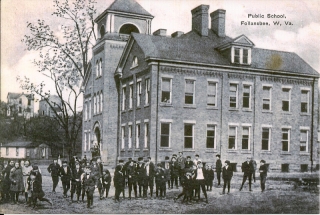
Jefferson School circa 1918; annex, left, built in 1920 for overflow. Photo courtesy of James Piccirillo
1906 – Sugar Grove & Other Schools In Vicinity Of Follansbee
Sugar Grove, a one-room school, was located at the east end of what is now Neville Street. Its name originated from the beautiful sugar maple trees in the surrounding area. The school dated back over 60 years serving the small community prior to the coming of the Follansbee brothers. Some of the pioneer families attending the school were: the Mahans, Bevinneys, Wheelers, Latimers, Allisons, Hamiltons, Walkers, Brownings, Carters, and Mays. The early school teachers were: William A. Strain, May Latimer, George Bryte and Judge Hervey, who served as a judge of the Circuit Court.
J.A. Walker Recalled Building Sugar Grove School
J.A. Walker, a descendent of the pioneer Jacob Walker family, was interviewed by the Follansbee Review in 1938. J.A. recalled being among the residences involved in building the historic Sugar Grove Schoolhouse that served the scattered farming community prior to the founding of the city of Follansbee. “Mr. Walker quarried stone on his farm and hauled it by oxen to the scene of the schoolhouse.”
Mr. Walker recalled vividly the names of other pioneers who aided in the construction of the school. Among them were “Andy Halstead and his son, Doyle, Thomas Hill, Albert Hunter, and Ross Wright, the latter having hauled lumber from Steubenville.” At the time of the interview, Mr. Walker was well into his 80s, and a great, great grandfather with relatives throughout Brooke county.
*Follansbee Review, “J.A. Walker Recalls Building of School,” June 23, 1938, p.1.
1897 Sugar Grove photos – Cornelia (Brady) Waugh via Follansbee Brooke Co. Library.
Goodwill School’s Historical Significance
A summer picnic was planned by the Tri-State Historical Association to be held on the Wells farm, August 20, 1939. “The Wells farm on the Follansbee-Eldersville road was chosen because of the historical background of the St. John’s community and Tent Church district, and also because the first free educational institution, known as the Goodwill school, west of the Alleghany mountains was created on the Wells farm.
*Follansbee Review, “ Tri-State Historical Association Picnic..,” July 27, 1939.
Other one-room schools or small schools that existed in the Cross Creek District from 1864 to the early 1900s were the following:
- Hope Farm (uncertain of location)
- Franklin (Washington Pike)
- Colliers Mine (Located at coal mine)
- Cliftonville (Cross Creak mining area)
- Colliers (in village of Colliers)
- Morton School (Archer Heights)
- Goodwill School (St. Johns Road)
- Tent School (Tent Church Road)
- Ebenezer School (Near Louise – mining area on Cross Creek)
- Scott Run School (Near Virginville – mining area on Cross Creek)
- Stockdale School (Rockdale – on Cross Creek close to present day Brooke High School)
- Anderson (Archer Heights)
- The Shed (three-room building of boards near location of present Jefferson School)
- Fairy Glen School (On river bottoms north of Market St. Bridge, near Holliday Cove)

Rockdale School Cross Creek, circa 1916. Photo courtesy of W.Va. State Archives. (See Timeline, October 1915, Reports from District Schools)
1914 Report Card Photos Courtesy – George Pfister
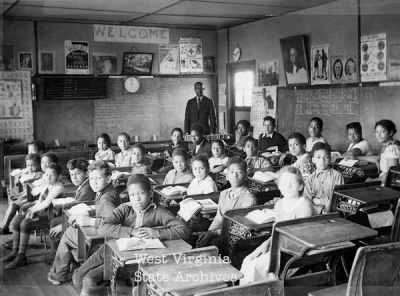
One-room Anderson (African-American) school was located on Archer Heights. Mr. Whittaker was teacher. Ernest D. Anderson is seated, first row, third from back. During the 1930s-50s, wooden steps allowed folks to walk up the rocky hillside from Market Street Bridge and East Steubenville area to Archer Heights where a number of African-American families lived. Photo: 1937 WV State Archives.
